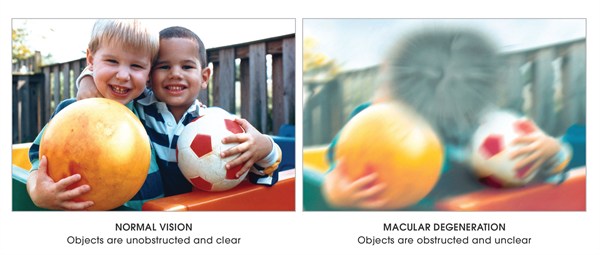
Macular degeneration is an age-related disease that affects the macula. It is the leading cause of vision loss in older Americans. The macula is located on the retina in the back of the eye. The macula is the center of the retina and its function is to provide color vision and the ability to see fine detail. There are two types of macular degeneration: dry AMD and wet AMD. Dry macular degeneration is the most common type of macular degeneration accounting for 80 to 90 percent of AMD. Dry AMD occurs when yellow spots called drusen begin to accumulate in and around the macula. In wet AMD, the drusen can break down the macula causing blood vessels beneath the retina to leak into the macula. This is the more serious type of AMD and can lead to more severe vision loss.
Who is at risk?
Smoking – doubles the risk for AMD
Race – AMD is more common in Caucasians, however risk for people of all races increases with age
Family history – people with a family history AMD are at a higher risk.
What are the symptoms?
A common symptom is a blurry spot in the center of your vision. Glasses and contact lenses do not provide clear vision. As the disease progresses, the central vision deteriorates leading to difficulty driving, reading, and recognizing faces. AMD affects central vision and can lead to serious vision impairment and disability.
How is AMD Detected?
During a comprehensive eye exam, your doctor will be able to determine if you have signs of AMD even before you notice symptoms. Additional testing includes:
Fundus photography – a photo is taken of the back of your eye to provide a baseline for the stage of macular degeneration and to monitor for changes over time.
Optical Coherence Tomography (OCT) – This technology uses light waves to image the layers beneath the retina to determine the severity of AMD. It is like a CT scan of the eye.
Amsler grid – This test is a grid that has a black circle in the middle, AMD causes the lines in the grid to disappear or appear wavy. This test can be taken home and patients can monitor for changes in their vision.
How is AMD treated?
There is no FDA-approved treatments for early dry AMD. For intermediate AMD, the Age-Related Eye Disease Study 2 (AREDS 2) showed that taking a specific formulation of can reduce the risk of intermediate AMD to severe AMD by 25% over a 5 year period. The ingredients are below:
500 milligrams (mg) of vitamin C
400 international units of vitamin E
80 mg zinc as zinc oxide
2 mg copper as cupric oxide
10 mg lutein and 2 mg zeaxanthin
In wet AMD, treatments include injections of medicine in the eye and laser therapy to reduce the amount of blood vessel growth. The treatments can stop or slow the progression of wet AMD, but vision that is loss cannot be recovered. The best way to protect your eyes for a lifetime is to have yearly eye exams and follow the advice of your eye doctor. Call us at (925) 744-7900 to schedule your eye exam today.




